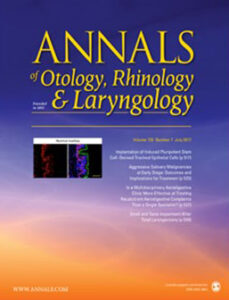Otorhinolaryngology
Publication Types:

Simulation-based surgical training needs in otorhinolaryngology
Introduction: This study aimed to conduct a targeted needs assessment to identify and prioritise technical skills and procedures suited for simulation-based training (SBT) in private otorhinolaryngology (ORL) practice in Denmark, including mapping the learning environment related to implementation of SBT.
Methods: A panel of trainers and trainees in private ORL practice was recruited. Using the Delphi method, three rounds of surveys were conducted. Round one consisted of a survey of the learning environment and a brainstorming phase. Round two quantified the frequency of procedures, ranked the importance of procedural competency, impact on patient safety and feasibility for SBT. In round three, panelists eliminated and ranked procedures for final prioritisation.
Results: A total of 26 of 57 invited trainers and trainees accepted participation. The educational environment was described and 136 skills were suggested in the brainstorming phase. “Non-technical” skills were removed, and the remaining 46 technical skills were grouped for appraisal in round two. In round three, panelists reduced these to eight technical skills and procedures which were maintained for final prioritisation for SBT with myringotomy with ventilation tube insertion ranking highest. Trainees and trainers indicated that close supervision and dedicated time for training were major strengths of the learning environment.
Conclusions: Our findings extend the results obtained in a previous general needs assessment and may inform curricular implementation of SBT in private ORL practice. A structured “package” with SBT and assessment for the identified procedures are desired by trainers. This work is already in progress and implementation is facilitated by a positive attitude towards SBT among trainers and trainees alike.

Use of simulation-based training of surgical technical skills among ENTs: an international YO-IFOS survey
Purpose: The aim of this study was to investigate and compare the use of simulation-based technical skills training (SBTST) in the otolaryngology curriculum in different countries, and to explore the needs and opinions about the use of simulation among young otolaryngologists.
Methods: An e-survey conducted among Young Otolaryngologists of the International Federation of Oto-rhino-laryngological Societies (Yo-IFOS) members.
Results: 139 Yo-IFOS members from 51 countries completed the survey. During residency training, 82.7% of respondents have used SBTST on cadavers, 51.8% on physical simulators, and 43.8% on virtual reality simulators. High costs (65.5%), lack of availability (49.2%) and lack of time (25.5%) were the main barriers limiting the practice of SBTST. These barriers also limited teaching using simulation. Sinonasal surgery (72.7%), temporal bone surgery (67.6%), and head/neck surgery (44.6%) were significantly more frequently taught using SBTST than suspension microlaryngoscopy (25.9%) and pediatric surgery (22.3%) (p < 0.001). The procedures rated as the most important to learn through SBTST were tracheotomy (50.4%), emergency cricothyroidotomy (48.9%), and rigid bronchoscopy (47.5%). On an analogic visual scale (0-100) for the question “how important will simulation be for future ENTs in surgical training?”, the mean score was 79.5/100 (± 23.3), highlighting the positive attitude toward the use of SBTST in otorhinolaryngology training.
Conclusion: SBTST is an attractive learning and teaching method in otorhinolaryngology, but associated costs, lack of access, and lack of time are the main barriers limiting its use. Emergency procedures are key technical skills to be learned using simulation but in some cases, lack relevant simulators for training.

Evidence of Mobile Apps in ORL targeted at patients

Developing a national e-learning course in Otorhinolaryngology: the Danish experience
PURPOSE: E-learning provides a flexible and effective approach to learning and is increasingly used in otorhinolaryngology (ORL). We developed a national theoretical e-learning course for ORL trainees and describe our experiences with implementation as well as piloting the e-learning course.
METHODS: E-learning course content was developed as structured multiple-choice quizzes for the European core curriculum textbook. An open source learning management system was adapted for a self-paced e-learning course. We piloted the e-learning course as a non-mandatory option for the 15 residents participating in the Danish four-day national training course in rhinology in February 2019. A post-course survey was sent out to the participants and used in the evaluation along with activity data from the learning management system.
RESULTS: Fourteen out of 15 trainees participated in the e-learning course. Nine participants completed >95 % of the course. The activity data demonstrated that participants with the highest completion rate typically began well in advance of the course (>2 months). Overall the e-learning course was rated positively in relation to learning and as preparation for the national training course. Participants responded that the level of the e-learning course was higher than and also at times in slight incongruity with the content of the national curriculum. Participants would like protected study time for e-learning activities in their residency program. All participants responded that they would use e-learning in relation to future national training courses.
CONCLUSIONS: Developing a national e-learning course is feasible and is well-received by trainees as well as other educational stakeholders.
